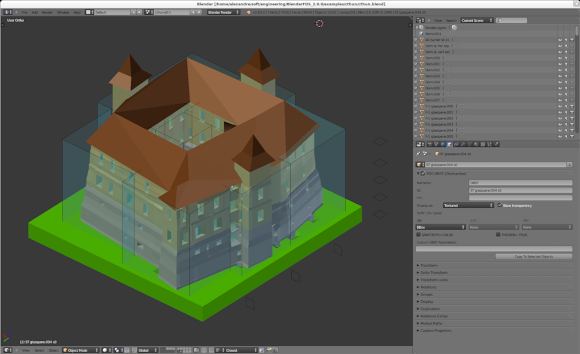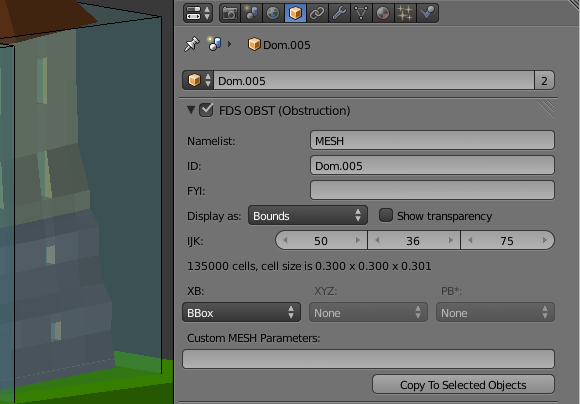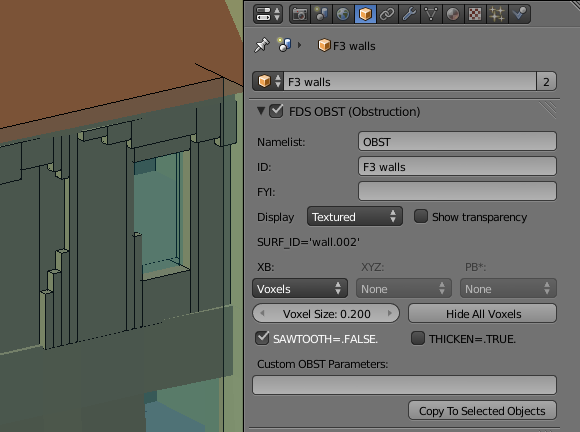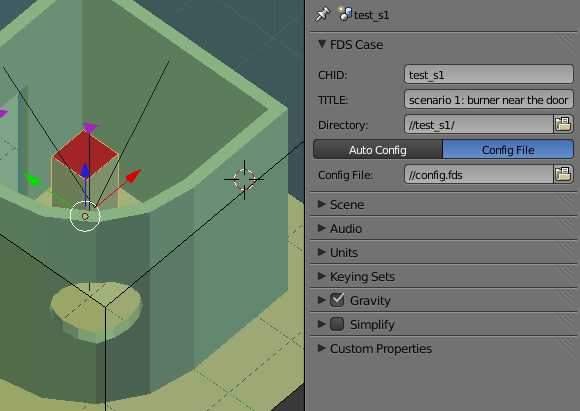Emanuele Gissi on Blender Fire Dynamics Simulator
Emanuele Gissi released a major update of BlenderFDS, a Blender-based user interface for NIST Fire Dynamics Simulator.
The new version depends on currently unreleased Blender 2.64 and introduces voxel generation via the relatively new Remesh modifier. Not only this makes voxelization faster, more precise, reliable and resilient: you can now visualize and modify voxels before exporting.
Speaking of which, BlenderFDS now also fully supports BMesh, so we are talking about state of the art Blender features here.
Several improvements were added to the proposed workflow. For instance, BlenderFDS got has better IJK parameter management, and the OUTLINE=.TRUE. parameter is now automatically handled.
The new version also got its third test case: a complete project for Castle Thun, a historic castle from the 13th century which has typically irregular geometry. Work on analysis of fire scenarios in the castle was done by Emanuele from March to June 2012.

The interview
It’s quite spectacular that Emanuele Gissi, the project lead, has managed to achieve so much in just 3 years, so we asked him to answer a couple of questions about his work.
Emanuele, what is your background in fire dynamics simulation?
I am the deputy fire commander of the Comando provinciale dei Vigili del fuoco di Genova, that is, the Genoa fire brigade. I work as a professional firefighter, simulating fire scenarios is only a (too small) part of my daily occupation.
What we mainly provide to the 900,000 citizens of the Genoa province is civil protection, fire response, technical rescue, safety at work, fire prevention, safety training.
In the frame of fire prevention, we peer review fire safety projects of new and existing civil and industrial activities. This is why we use fire CFD models.
What was the situation with free FDS tools prior to the inception of BlenderFDS?
First of all, here is some background.
NIST Fire dynamics simulator (FDS) is a computational fluid dynamics model of fire-driven fluid flow, mainly developed at the National Institute of Standards and Technology (NIST), a federal agency within the Department of Commerce of the United States.
The software solves numerically a form of the Navier-Stokes equations appropriate for low-speed, thermally-driven flow, with an emphasis on smoke and heat transport from fires. FDS was publicly released in 2000.
As for NIST developers’ explicit choice, FDS is exclusively being developed as a CFD code only, so no user interface is available to the user, except for a command line interaction mode, but limited to the mere processing control.
Thus the input data pre-processing phase is completely left to user responsibility: all the necessary information to perform an FDS simulation has to be contained in a single text file. The input file is written using a specialized description language, following the syntax of namelist groups from the Fortran programming language and a semantic specification peculiar to FDS.

In real world cases, especially where complex or curved geometries are to be described, the data input phase represents an important cost for the fire engineer.
Back in 2009, several third-party pre-processing tools and add-ons to FDS that simplified and streamlined the data input phase were available; in the opinion of the authors, each of them had several limitations, the perceived most notable one was the lack of flexibility.
No open source and freely available pre-processing tool existed at the time.
So how did you get started implementing the tools on top of Blender?
In 2009 the Comando provinciale dei Vigili del fuoco di Genova, a branch of the Italian national fire and rescue service, fostered the development of a new, open-source, community-based user interface for FDS, in the frame of a wider project whose goal was lowering the entry barriers for fire engineers to CFD fire simulation tools.
Several research institutions, as the DIPRADI — Politecnico di Torino, the DII — Università del Salento, and numerous individuals from the FDS user community contributed resources, ideas and code to what has evolved to be the BlenderFDS tool.

The working group constituted by the Comando provinciale dei Vigili del fuoco di Genova produced a draft blueprint of the new FDS pre-processing tool. Following a bottom-up approach, the draft blueprint was informally submitted to the members of the FDS user community for review.
Following that review, Blender platform was selected as the base for further development: open source, available for all major operating systems, easily extensible through its well supported and documented Python application programming interfaces (APIs).
The revised blueprint was then presented at the Blender Conference 2009, and received several additional contributions by 3D modeling specialists and Python developers from the Blender community.
In a discussion at LinkedIn last year you said you didn’t have even a rough estimate of how many people used BlenderFDS. Is that still so? Why?
Yes, I still do not have an estimate of how many people use BlenderFDS: it is a niche tool, for very specialized users.
CFD tools are intended for use only by those competent in the fields of fluid dynamics, thermodynamics, heat transfer, combustion, and fire science.
Both inherent complexity of 3D modeling tools and the peculiar interface of BlenderFDS can involve the need of a non-negligible investment of resources for new users to become productive.
BlenderFDS is intended for users that already have a basic knowledge on how FDS works and can autonomously write FDS input files. BlenderFDS does not facilitate in any way the learning curve of students and professionals approaching the fire safety engineering topics.
These peculiarities still represent an important barrier to the adoption of both FDS and BlenderFDS.
Still, each new BlenderFDS revision is downloaded around 400 times during its valid life. I often meet people at fire safety conferences around the world thanking me for BlenderFDS. The BlenderFDS group is receiving more and more requests for assistance.
Did you make any attempts collecting a list of most interesting use cases for the project? I know that you ship a few projects with the package, but those come from your own work, right?
Yes, those test and example cases included in BlenderFDS 2.0 distribution come exclusively from my own work. I hope this will change in the not too far future.

My attempts to collect use cases are ongoing. The main problem is that fire safety engineers are not eager to publicly distribute the result of their professional work. I currently have several use cases pending for user permission of redistribution.
Are you staying in touch with folks from ODS Engineering who create a complete Blender-based solution for architects?
Yes, they got in touch with me some time ago. They seemed to be very interested in integrating the fire part into their tool. But I think they are currently more focused on other activities.
I do not exclude that future could reserve fruitful surprises on that side. I believe a lot in integration and resource sharing.
Judging by your own experience and your interaction with users, how good is Blender for architecture-related projects?
Blender is a very flexible tool, it is easily adaptable to different needs. Some further attention to precision modeling tools would facilitate the life of engineers and architects. Fortunately someone is already working on that via Google Summer of Code 2012 program.
But Blender is not and will never become a CAD. On this side I am following the development of FreeCAD. I bet that Blender and FreeCAD will become complementary tools for designers.
FreeCAD has good STEP/IGES support, but I’m primarily interested in the possibilities opened by parametric modeling. Imagine comparing different fire safety designs. A vent could be here or there, could be big or small… This makes the difference when dealing with smoke management.
What major work on the project do you think is still ahead? What are your personal priorities?
Having more dedicated resources, one of the main goals would be importing back in Blender the FDS-calculated fire and smoke. This would be physically meaningful fire and smoke. Blender could then be used to produce highly effective training videos of fire development in buildings.
The task is open, the file formats are open and documented. Anyone out there willing to help?
With the current workforce, I can only guarantee full maintenance of the tool and the development of new features when the necessity appears from real world projects.
Sliding on a personal side, my first priority is still dedicating as much time as possible to my wife and my three children. The rest is a plus.
Patreon subscribers get early access to my posts. If you are feeling generous, you can also make a one-time donation on BuyMeACoffee.
